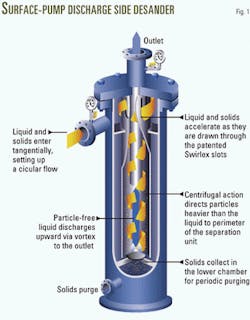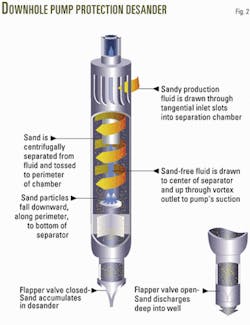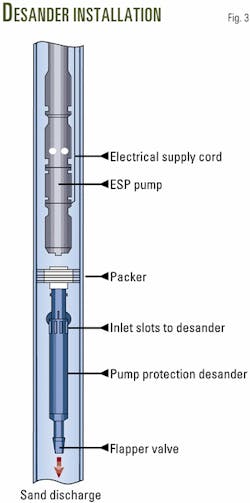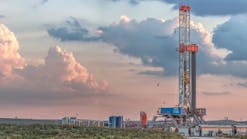Field tests in Canada demonstrated the effectiveness of a downhole desander to protect electric submersible pumps (ESPs) from failure caused by the production of formation sand. An abrasive environment can cause radial wear of the pump bearings, leading to vibration, which inevitably results in equalizer and motor failure.
Erosion of diffusers and impellers also reduces the efficiency of the pumping system, resulting in less than optimal production from the well.
Husky Energy Inc., formerly Renaissance Energy Ltd., initiated the tests as part of its efforts to reduce operating costs, 24% of which it attributed to well workovers and related servicing costs. The combination of high volume lift systems and sand production is the predominant factor behind these high costs.
Cantuar Unit
Husky identified its Cantuar Unit, in southwestern Saskatchewan, as among its critical areas for cost reduction. In this unit, the producing reservoir has a 12-14 m thick, fine to medium grained quartz arenite, semiconsolidated sandstone that is laterally continuous and fairly homogenous throughout the unit.
The sandstone has a 25-28% average porosity and a 1-darcy average permeability.
In the Cantuar Unit, Husky had 30 operating ESPs and plans called for doubling that number of pumps, but only if something could be done to control the pump damage and related costs.
The average ESP run life in the Cantuar Unit was 406 days, with some pumps running as few as 103 days.
Desander choice
In search of a solution to formation sand production, Husky decided to test a desander for downhole pumps that was made by the same manufacturer, LAKOS Filtration Systems, Fresno, Calif., that provided the surface desanders for their production streams.
The surface production-stream desander employs centrifugal action to separate the heavier-than-water particles from the water stream (Fig. 1). Each unit operates within a prescribed flow range at a low and steady pressure loss. The desander has no moving parts, no screens or filter elements to clean or replace, and requires no backwashing.
The removal of separated particles also does not require pump or system shutdown, enabling continuous and uninterrupted operation.
The surface production-stream desanders use an automatic valve to flush away the separated sand, but the downhole-pump protection models operate with a self-cleaning technique.
Use of these downhole desanders in the groundwater industry has produced at least a four-fold increase in pump life.
To test the downhole desanders (Fig. 2), Husky installed 12 in wells over a 2-year period, beginning in 1999.
Test objectives
Husky established the following test objectives:
- The pump-protection desander will separate sand in the oil field downhole environment. Sand buildup in the well sump and a lack of erosion or wear to the ESPs would indicate success because Husky did not install sand-production monitoring equipment.
- The pump-protection desander will not cause the production equipment to sand up. This would be determined if the equipment could be removed from the well, trouble-free, at the time of inspection.
- The pump-protection desander will extend the current pump's producing life. This would be evaluated based on past pump data, run time measurement, and pumping efficiency calculations.
- The installation will reduce oil production rates. Sand buildup in the well would reduce the inflow performance of the well. This condition could be determined by monitoring and comparing total fluid and oil rates.
Manufacturing, operating parameters
Although oil field water can be corrosive, the Cantuar Unit fluid did not appear to pose such a risk to standard carbon steel construction. An inspection of existing desanders in the Husky production streams also dispelled any concern for abrasive wear to the pump-protection desanders.
The manufacturer, however, made the test desanders with stainless steel and a Viton flapper valve to achieve a material hardness of 95 Rockwell B. This effectively neutralized any potential for wear to the desander so that the test objectives could be isolated from other possible failures, no matter how remote.
An external upset (EUE) pipe connection threading matched the field equipment specifications. No other operating conditions influenced any changes in material or design specifications.
Operating conditions were:
- Electric submersible pump.
- 275 - 960 cu m/day flow.
- 2% maximum gas rate by volume at operating conditions.
- 95% water and 5% oil flow.
- Sand, silt, and clay solids.
- 2.6 solids specific gravity.
- 1 µm - 9.5 mm particle size.
- 1-10,000 ppm solids concentration (100-ppm average)
- Ambient temperature.
Applications characteristics
Because of the concern for excessive sand accumulation in the well, Husky selected wells with boreholes of 7-in. ID that provided ample annular space in the event that the pump might sand up. Additionally, adequate well depth below the pump setting was also a factor in well selection. Wells selected include those with at least a 20-m sump.
Oil field ESPs offered no substantial operating differences to the groundwater pumps commonly installed with the pump-protection desanders. The most important selection factor was good pump history. This history established benchmarks for comparing pump run life and efficiency.
To maximize the testing objectives, Husky selected wells with pumps that had a short run life.
It selected pumps with a moderate flow rate, 275-480 cu m/day fluid, to test desanders with a reasonable size, price, and handling capability.
A steady flow rate, as compared to periodic slug flow, optimizes desander performance. The expected 95:5 water-to-oil ratio posed no risk to the desander's performance.
The desander's maximum gas handling capacity is 2% GOR. Higher GORs could be handled with additional sizing calculations.
Fig. 3 shows the installation selected from many options possible. While this technique required two procedures to set the pump and the desander in the well, it also minimized retrieval complications if the well sanded up.
A packer is a common method for positioning the desander, effectively isolating the ESP from the well's production (and sand-laden) perforations and directing flow through the desander prior to the pump intake.
Post-test inspection
Husky shut down and pulled the first test desander for inspection after operating it for 203 days.
This particular well had a history of severe sand damage. Its three previous pumps lasted an average of only 126 days (maximum 143 days, minimum 103 days). All operating conditions at the time the first desander was retrieved appeared to be stable (Table 1), causing no other reasons for Husky to shut in the well other than for gathering test data.
The pump and desander were pulled without incident, indicating no sand up conditions. The well sump revealed a new depth difference of 4.67 m, all attributable to the desander's separation and purging of sand into the well instead of passing that sand through the pump.
On site pump inspection indicated that the pump was in good condition, with no shaft play and clean oil throughout the equalizer and motor. After the pump was shipped to the pump manufacturer for a full test and comparison to original bench tests, the pump manufacturer measured a head capacity reduction of only 4.6% at its best efficiency point (bep).
A thorough breakdown inspection of the pump revealed that the impellers and diffusers had only minor sand erosion and the radial support bearings had minimal damage. This condition compares significantly better to the catastrophic failure observed in the three previous pumps in this particular well after much shorter operating cycles.
The desander manufacturer inspected the desander and considered it to be in excellent condition. It rated a minor polishing at the edges of the inlet slots as normal and insignificant, found no evident internal sidewall erosion, and noted minimal wear on the internal deflection pedestal.
It did find a slight tear of the flapper valve but did not determine its origin. The tear did not appear to reduce operation or performance.
Operating, objective comparisons
The pump-protection desander afforded the test ESP to have a significantly longer run time and better overall efficiency than any previous pump in that particular well. Also, fluid pumping rates were higher than expected.
The pump-protection desander tests showed that:
- The desander will separate sand in the oil field downhole environment. An accumulation of 115.8 l. of sand in the well sump provided strong confirmation that the desander was removing sand from the production fluid, discharging it into the well sump, and keeping sand out of the pump.
- The desander will not cause the production equipment to sand up. Removal of the pump and desander for inspection was trouble-free, and the packer showed no evidence of sand accumulation above, indicating little or no occurrence of sanding up.
- The desander will extend the current pump's producing life. The maximum pump run life for this particular well without a desander was 143 days, with one pump lasting only 103 days. The inspection after 203 days clearly indicated that the pump would continue to operate at reasonable performance for some time to come. In fact, it was still operating at an efficiency of 60%, optimal for its design and application conditions.
- The test indicated no negative impact on oil production rates. The well continued to produce oil at an average rate of 25 cu m/day, which matched the predicted oil rate, based on inflow performance relationship data. The data indicated that the desander did not significantly reduce inflow performance of the well.
- This desander matched or exceeded all of the established expectations. As a result of this testing, LAKOS has since engineered a specific PPD Series of pump protection desanders exclusively for the oil and gas industry, featuring industry-standard materials, connections and specifications.
The author
Michael Briffett is a completions engineer with Husky Energy Inc.'s offshore east coast Canada operations. He previously worked as a production engineer and a reservoir engineer for a number of companies in Western Canada. Briffett holds a BS in mechanical engineering from Memorial University of Newfoundland.







